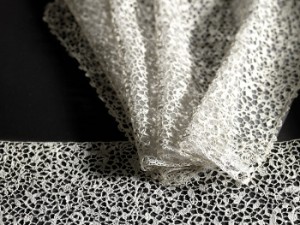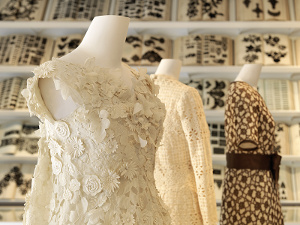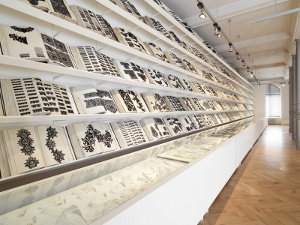
St. Gall – Textile History across 8 centuries
March 26 – December 30, 2011
Textile Museum St. Gallen, Switzerland
http://www.stgall.ch/
Catalogue:
“StGall – Textilgeschichten aus acht Jahrhunderten” , German only
ISBN: 9783039192144
This article has originally been published in the online version of the HandEye magazine, and is republished with permission.
When in January 2009 Michelle Obama’s lemon grass coloured inauguration dress adorned the front page of virtually every newspaper across the world, only a selected few were aware that the dress’ exquisite Guipur wool lace fabric is the result of over 800 years of skilled artisanry.
Laces have been a firm part of haute-couture since the medieval, and many a historic portrait is not complete without the characteristic fabric prominently featured by personalities such as the French sun king Louis XIV, the English king Henry VIII, Napoleon, or – most recently – Kate Middleton, the newly wed wife of the heir to the British throne. Lace work was so highly valued at one time, that – so it is said – a French nobleman even sold his best vineyard to raise the cash and buy a collar made from this exquisite material, with the result that jokes about him wearing a vineyard around his neck started making the rounds much to the citizenry’s great amusement.

Lace fabric still is, and always has been, a luxury product. Since the 1940s, rather than political and social celebrities, it is the likes of Chanel, Dior and Prada that adorn their names with these intricately designed fabrics. The history of lace work is akin to a travel through time, featuring the best of European textile artisanry and technology.
Interestingly, nearly all historic roads in lace work craftsmanship lead to St. Gallen, a small city in the East of Switzerland. The international lace trade of the 18th and 19th century made St. Gallen rich and famous, a fact that is still reflected in the city’s architectural legacy and the names of what used to be the merchants’ homes: Pacific, Oceanic, Atlantic, Chicago, Britannia, Washington, Florida …. But it is laces that form the lasting foundations of an industrial tradition that remains as much at the pulse of high-end textile innovation in the present as it did in the past.
St.Gallen’s centuries old textile industry built its reputation in the early medieval through to the beginning of the 18th century as a result of their linen production. The linen industry gave St. Gallen its nickname, ‘the white city’, due to the many fields at its outskirts being covered with linen cloth laid out to dry and bleach in the sun. With the start of the Thirty Years’ War in the early 17th century however, the use of linen for fabrics production declined, and the fibre was gradually replaced first by half-linen, then by wool mousseline and finally by more expensive, imported fibres such as cotton and silk. The relative peacefulness in war-torn times was a historic opportunity and kick-started the modern incarnation of the city’s textile industry: lace work artisans from all over Europe came to the city and made it their home. They first perfected their craft in close collaboration with the local textile specialists, and later adapted it to emerging technologies notably steam driven embroidery and lace machines. Ever since, lace work ‘made in Switzerland’ has been the subject to transition, sometimes even radical change, and at the beginning of the 21st century the wide spread availability of digital technologies triggered yet again a period of innovation in St. Gallen’s lace work history.

The currently ongoing ‘StGall’ exhibition in St. Gallen’s textile museum is centred around a world-wide unique collection of lace samples and swatches that are at the core of the museum’s library, and which previously have only been accessible to industry experts and researchers. On three floors the library’s treasures are unveiled and accompanied by concise explanations about the historic and cultural context of their times. From embroidered flower themes, to abundantly decorated Renaissance gowns, veils, collars, bobbin laces representing the German imperial eagle to the colourful and glittery version of modern haute-couture designs, the exhibition sheds a glorious light onto the treasures of the past, and hints at the fascinating perspectives of the future.
The over 800 years of lace history are defined by innovative creativity, a lasting ability for adaptation and visionary technical achievements. But maybe more importantly, laces are the stuff fashion dreams still are made of, prove of which bear the visitors who are left marvelling at the exquisite, art-work like fabrics.

